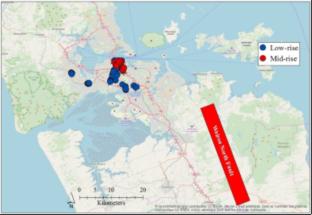Seismic risk assessment for commercial masonry infill buildings within the Auckland region of New Zealand
Abstract
Following the 2010/2011 Canterbury, New Zealand earthquake sequence, Auckland Council actively identified and assessed commercial buildings within the Auckland region to establish whether they were earthquake prone. Masonry infill buildings are one class of building type that was considered to be potentially earthquake-prone, with this building type constituting a significant proportion (9%) of all commercial buildings in the Auckland region. Despite the Auckland region being categorised as a low seismicity region in the current New Zealand seismic loadings standard, rupture of the Wairoa North fault located within the Auckland region could potentially generate significant earthquake shaking in the future. The reported study was undertaken to forecast the damage distribution for low-rise and mid-rise masonry infill buildings when subjected to ground motions from the Wairoa North fault that incorporated a combined mainshock-aftershock earthquake sequence. The results showed that mid-rise masonry infill buildings were forecast to exhibit significant damage when compared to low-rise masonry infill buildings. In addition, the seismic risk associated with mid-rise masonry infill buildings was forecast to significantly increase when aftershock earthquake scenarios were applied. It is noted that the increased seismic risk of mid-rise masonry infill buildings (when compared to their low-rise equivalent) was unsurprising because post-earthquake observation following the Canterbury earthquake sequence showed that mid-rise masonry infill buildings sustained higher levels of damage in comparison to low-rise masonry infill buildings.


 求助内容:
求助内容: 应助结果提醒方式:
应助结果提醒方式:


